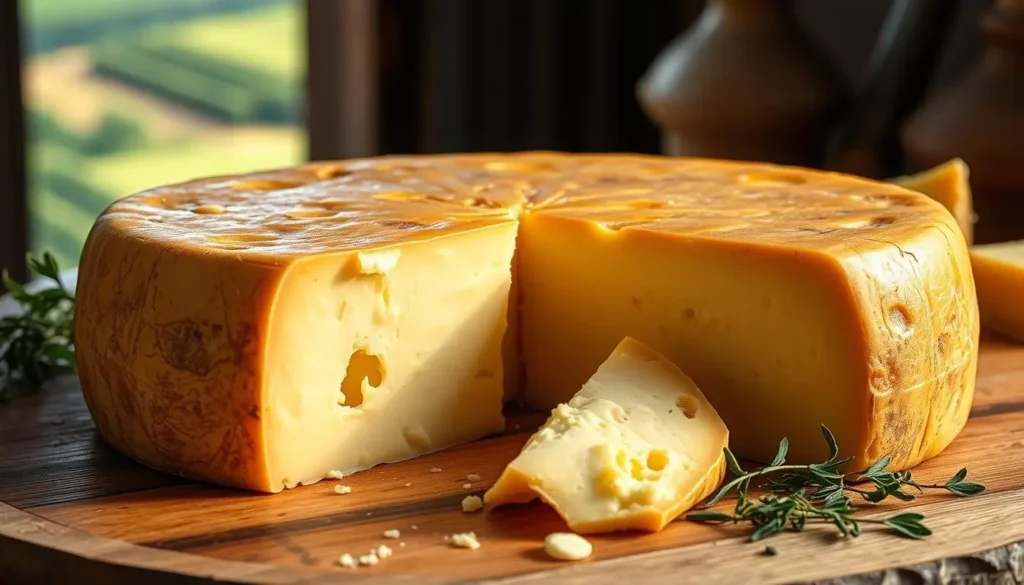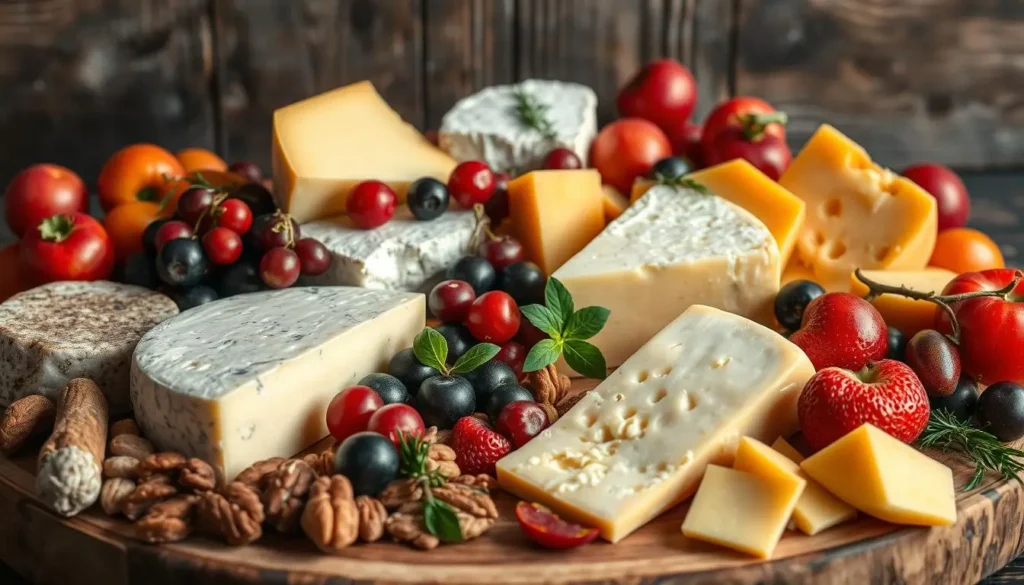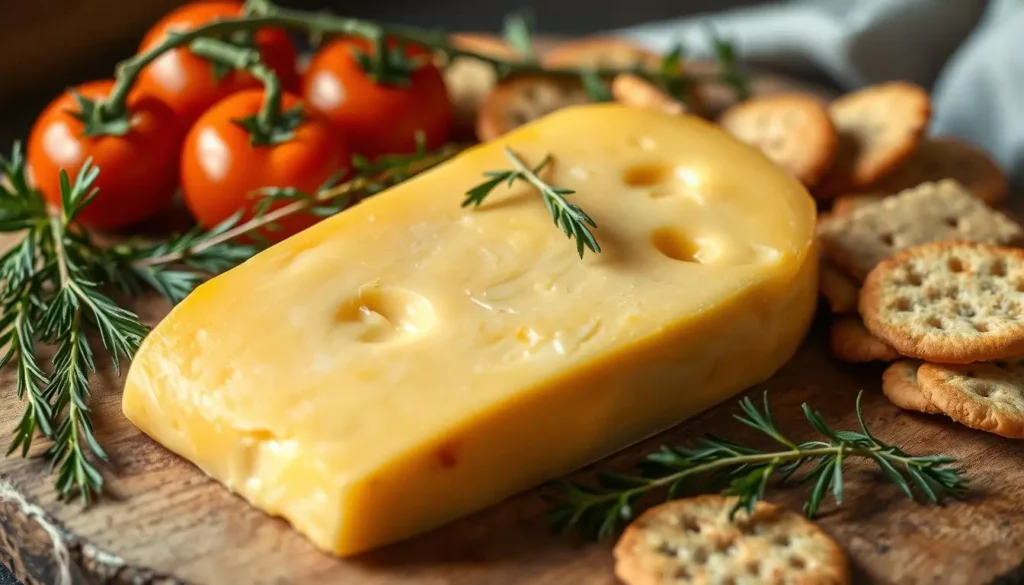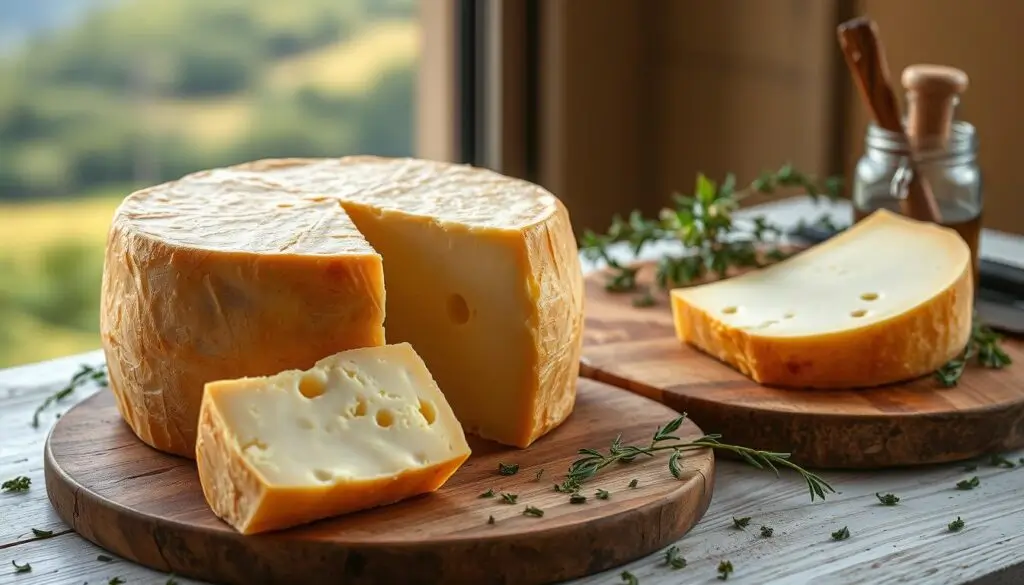Provolone cheese is known for its rich, bold taste. It comes from Southern Italy, where it’s been made for years. This cheese is great in many dishes, like sandwiches and pasta, with a sharp yet smooth flavor.

Provolone is more than just cheese; it’s an experience waiting to be discovered. Whether you love cheese or want to try something new, provolone is a fantastic choice. Its aged quality gives it a special character that makes it stand out among other cheeses.
Key Takeaways
- Provolone is a type of italian cheese known for its bold flavor
- It originates from Southern Italy and is often used in various dishes
- Provolone has a distinctive taste that is both sharp and smooth
- It’s an aged cheese with traditional production methods
- Provolone is a great choice for cheese enthusiasts and those looking to try something new
- Its unique character sets it apart from other types of italian cheese, including other provolone varieties
The Rich Heritage of Provolone Cheese
Provolone cheese has a long history that spans centuries. It comes from Southern Italy, especially Campania and Apulia. The way it’s made, by heating and stretching the curd, gives it a unique shape and taste.
In Italy, Provolone is a big part of family gatherings and special events. It stands for warmth, hospitality, and tradition. When you try Provolone, you’ll see how its flavor is shaped by the region and its making process.
Origins in Southern Italy
Southern Italy is famous for its beautiful landscapes, rich history, and lively culture. These factors helped create Provolone cheese. The area’s fertile soil and mild weather make great milk for this cheese.

Traditional Production Methods
The way Provolone is made is key to its taste and texture. Heating and stretching the curd gives it its special shape and flavor. When you taste it, you’ll see the skill and care that goes into making this cheese.
Understanding Provolone’s Unique Character
Exploring provolone reveals its unique traits. It comes in two types: Dolce (mild) and Piccante (sharp). The aging time, from a few months to years, shapes its flavor. Whether you like Dolce’s creamy taste or Piccante’s sharpness, provolone caters to all.
Some key characteristics of provolone include:
- Mild, creamy flavor in Dolce provolone
- Sharp, tangy flavor in Piccante provolone
- Versatile uses in cooking, from sandwiches to pasta dishes
The aging process is key to provolone’s taste. With various aging options, you can find the ideal provolone for your taste.

In summary, knowing provolone’s unique traits is key to enjoying its rich flavor and versatility. By exploring different types and aging processes, you can find the perfect provolone for your dishes.
| Type of Provolone | Flavor Profile | Aging Process |
|---|---|---|
| Dolce | Mild, creamy | 2-3 months |
| Piccante | Sharp, tangy | 6-12 months |
How Provolone Is Made
Provolone cheese starts with top-quality milk. It’s then heated and stretched to form its unique shape. This careful process ensures a delicious cheese.
The aging process shapes Provolone’s taste. It can last from a few months to a few years. This creates different flavors and textures, making Provolone versatile.
The Aging Process
Provolone ages for 2 to 3 years. During this time, it’s turned and checked often. This ensures it gets the right taste and texture.
Different Curing Methods
Provolone can be smoked or salted. Smoking adds a deep flavor, while salting enhances taste and keeps the cheese fresh. Each method makes the cheese unique.
Quality Control Standards
Provolone makers follow strict quality rules. They test the milk and cheese regularly. They also watch the aging and curing closely to get the best flavor and texture.
By sticking to these standards, Provolone producers make a top-notch cheese. It’s perfect for many dishes, like a tasty provolone sandwich.
| Type of Provolone | Aging Period | Flavor |
|---|---|---|
| Young Provolone | 2-3 months | Mild, creamy |
| Aged Provolone | 2-3 years | Sharp, savory |
Varieties of Provolone
Exploring cheese varieties, you’ll find provolone stands out. It offers flavors and textures for everyone. From mild, creamy to sharp, aged, provolone has it all. Its origins in Southern Italy have led to many shapes and sizes, each unique.
Common provolone types include the Provolone Ball, Log, and Sausage. These differ in shape, flavor, and texture. For instance, a mild provolone is great for sandwiches. A sharp, aged one is perfect for grating over pasta or salads.
- Provolone Ball: a mild, creamy variety perfect for sandwiches and snacks
- Provolone Log: a semi-sharp variety great for grating or slicing
- Provolone Sausage: a sharp, aged variety perfect for adding depth to sauces and soups
Provolone is versatile in cooking, from Italian classics to new dishes. Its rich flavor and smooth texture enhance any meal. Its various shapes and sizes make it easy to use in cooking and entertaining.
Culinary Applications and Pairings
Provolone’s rich, buttery flavor is a key part of many Italian dishes. It’s great in a simple provolone sandwich or in more complex recipes like lasagna or chicken parmesan. The trick is to pair it with ingredients that complement its bold taste.
Some classic Italian dishes that feature Provolone include:
- Caprese salad: fresh mozzarella, tomatoes, and basil, dressed with olive oil and balsamic vinegar
- Lasagna: layered pasta, meat sauce, and Provolone cheese, baked until golden and bubbly
- Chicken parmesan: breaded and fried chicken topped with marinara sauce and melted Provolone
For a quick snack, try a provolone sandwich with Chianti or Pinot Grigio. It’s also great with espresso or cappuccino. As an italian cheese, Provolone is perfect for many recipes, from appetizers to desserts.
Here’s a simple recipe to get you started:
| Ingredient | Quantity |
|---|---|
| Provolone cheese | 8 slices |
| Bread | 4 slices |
| Tomato | 2 slices |
| Basil | 1/4 cup |
Nutritional Benefits of Provolone
Exploring provolone reveals it’s not just tasty but also nutritious. It’s packed with essential nutrients, making it great for balancing taste and health. Its smooth texture and mild flavor make it perfect for adding to meals, boosting your overall health.
Looking at provolone’s nutrition, it’s key to focus on its main benefits. These include:
- High protein content, supporting muscle growth and maintenance
- Rich in calcium, crucial for strong bones and teeth
- Good source of phosphorus and zinc, minerals that play a vital role in various bodily functions
While provolone is high in calories and fat, it’s okay to enjoy it in moderation. There are also lower-fat and lower-sodium options for those with dietary needs. By adding provolone to your diet and watching portion sizes, you can enjoy its nutritional perks while staying healthy.
Storing and Serving Your Provolone
To enjoy provolone to the fullest, proper storage and serving are key. Wrap it in plastic wrap or foil to keep it moist. This helps preserve its flavor and texture.
For serving, slice it thinly for sandwiches, grate it over pasta, or enjoy it as a table cheese. The way you serve provolone greatly affects its taste and feel. Serving it at room temperature enhances its rich, buttery flavor.
Here are some tips for serving provolone:
- Slice it thin for sandwiches or paninis
- Grate it over pasta dishes, such as spaghetti or lasagna
- Serve it as a table cheese, paired with crackers or bread
By following these tips, you can fully appreciate the flavor and texture of provolone. Whether you prefer sharp, aged provolone or mild, young provolone, there’s a type for every taste.
Conclusion: Embracing the Versatility of Provolone
Provolone cheese is a true culinary gem. It offers a world of flavors and textures to explore. From its rich Italian heritage to its nutritional benefits, it delights every palate.
Whether you’re making classic Italian dishes or trying new recipes, Provolone makes them better. Its bold, aged perfection can elevate your cooking.
Provolone also pairs well with many wines and beverages. Try the perfect cheese and wine pairing or new flavor combinations. With Provolone, the possibilities are endless.
As you explore Italian cheese, let Provolone inspire you. Enjoy its rich, nutty flavors and the care in every wheel. Provolone is more than cheese; it’s a work of art for your kitchen.
FAQ
What is Provolone cheese?
Provolone is a type of Italian cheese with a bold, aged flavor. It comes from Southern Italy. It’s great in sandwiches and pasta.
What are the different types of Provolone?
There are two main types: Dolce (mild) and Piccante (sharp). Each has its own taste and texture. The aging process affects the flavor.
How is Provolone cheese made?
Making Provolone starts with choosing high-quality milk. The curd is then heated and stretched. Aging the cheese for months to years shapes its flavor.
What are the different varieties of Provolone?
Provolone comes in shapes like Balls, Logs, and Sausages. Each variety has its own flavor and texture, perfect for different dishes.
How can I use Provolone in my cooking?
Provolone is great in many Italian dishes. It’s perfect for lasagnas, caprese salads, and even pizzas. You can also enjoy it as a table cheese with wine.
What are the nutritional benefits of Provolone?
Provolone is rich in protein, calcium, and minerals like phosphorus and zinc. These are good for bones, teeth, and muscles. But, it’s high in calories and fat, so eat it in moderation.
How should I store and serve Provolone?
Store Provolone in the fridge, wrapped in plastic or foil. This keeps it fresh. Slice it thin for sandwiches or grate it over pasta. It’s also great as a table cheese.


3 thoughts on “Provolone Cheese: Indulge in the Exquisite Bold Flavor of Aged Perfection”
Comments are closed.